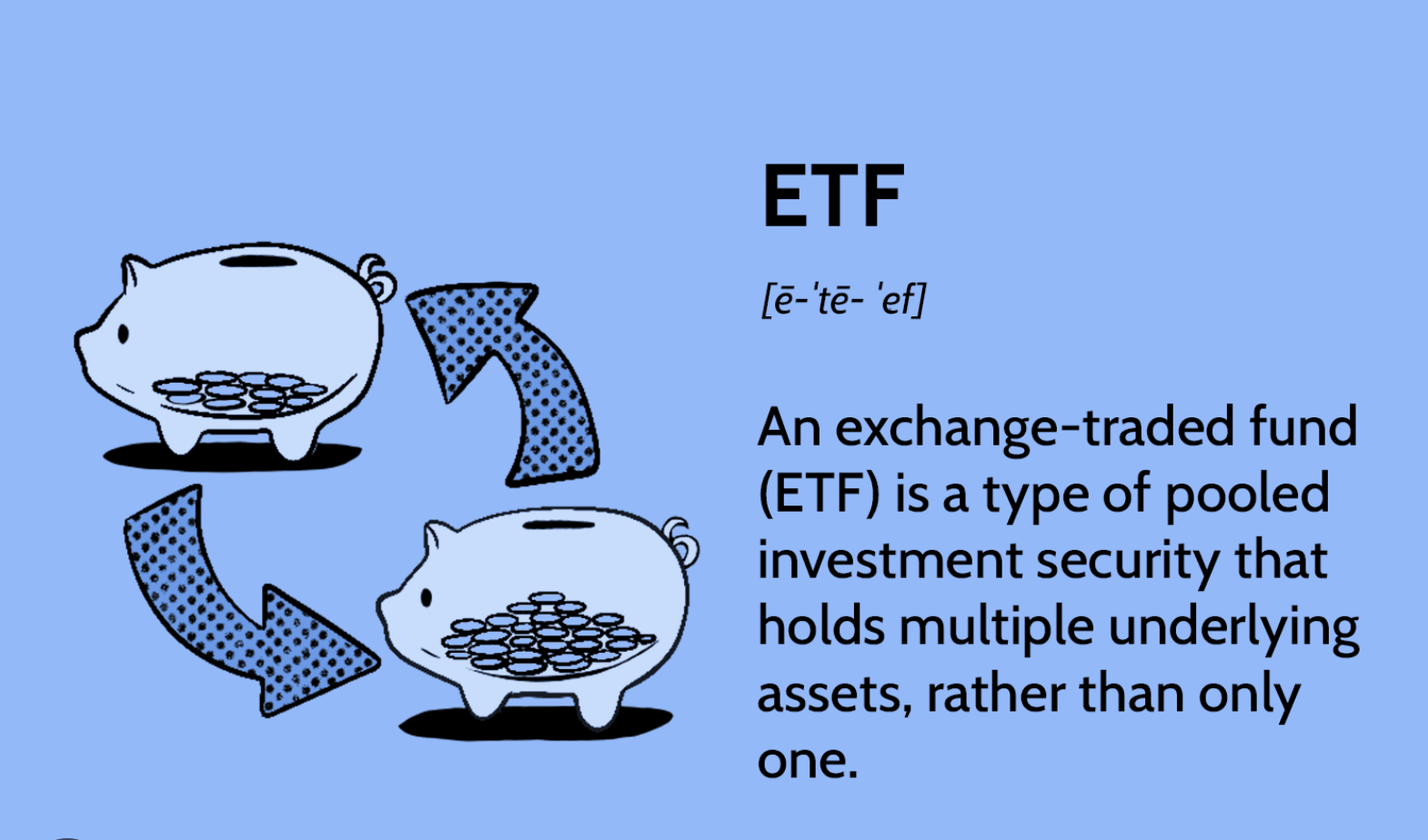ETF stands for Exchange-Traded Fund. It is a type of investment fund that trades on an exchange like a stock. ETFs are designed to track the performance of an underlying index or a basket of assets such as stocks, bonds, commodities or currencies.
ETFs offer investors the benefits of diversification and liquidity. They allow investors to invest in a particular market or asset class without having to purchase individual stocks or other securities. ETFs are also generally low cost and tax-efficient compared to other investment vehicles such as mutual funds.
ETFs are traded throughout the day, like stocks, and their prices fluctuate based on supply and demand in the market. Investors can buy or sell ETF shares on an exchange through a brokerage account.
How do ETFs work?
ETFs work by pooling money from investors and using it to purchase a basket of securities that track the performance of an underlying index or benchmark. For example, an ETF that tracks the S&P 500 index would buy a basket of stocks in the same proportions as the index, in order to replicate its performance.
ETFs are bought and sold on exchanges like stocks, which means that the price of an ETF is determined by supply and demand in the market. When an investor buys shares of an ETF, they are essentially buying a small piece of the underlying securities held by the ETF. The value of an ETF’s shares fluctuates throughout the day based on the performance of the underlying securities.
ETFs can be structured in different ways, such as physical replication or synthetic replication. In physical replication, the ETF buys and holds the actual securities in the underlying index. In synthetic replication, the ETF uses derivatives such as swaps to replicate the index’s performance.
ETFs can also be passively managed, meaning they simply track the performance of an index, or actively managed, meaning a portfolio manager makes investment decisions in an attempt to outperform the index.
Overall, ETFs offer investors a way to gain exposure to a diversified portfolio of securities in a cost-effective and convenient way.
How do ETFs and mutual funds compare?
ETFs and mutual funds are both investment vehicles that allow investors to diversify their portfolios across a wide range of assets. However, there are some key differences between the two:
- Trading: ETFs are traded on an exchange throughout the trading day like stocks, whereas mutual funds are priced once a day after the markets have closed.
- Cost: ETFs tend to have lower expense ratios than mutual funds. Expense ratios are fees charged by the fund for managing the portfolio. ETFs also tend to be more tax-efficient than mutual funds due to their unique structure.
- Minimum investment: Mutual funds typically have higher minimum investment requirements than ETFs. Some mutual funds may require a minimum investment of several thousand dollars, whereas ETFs can be bought in increments as small as a single share.
- Transparency: ETFs are more transparent than mutual funds, as their holdings are disclosed daily, while mutual funds disclose their holdings only quarterly.
- Active management: Mutual funds are typically actively managed, meaning a portfolio manager makes investment decisions in an attempt to outperform the market. Most ETFs are passively managed, meaning they simply track the performance of an index and do not attempt to outperform the market.
Overall, ETFs are a more cost-effective, transparent, and flexible investment vehicle compared to mutual funds. However, mutual funds may be a better choice for investors who prefer active management and are willing to pay higher fees for the potential of higher returns.
What do ETFs cost?
ETFs have different costs associated with them, including the expense ratio, trading commissions, bid-ask spreads, and potential taxes.
- Expense ratio: This is the annual fee charged by the ETF issuer for managing the fund, and it is expressed as a percentage of the fund’s assets under management. The expense ratio typically ranges from 0.05% to 1%, depending on the ETF. It’s important to note that the expense ratio is deducted from the ETF’s assets, which means it’s already factored into the ETF’s share price.
- Trading commissions: When you buy or sell an ETF, you will typically have to pay a trading commission to your broker. However, some brokers offer commission-free ETF trading, which can significantly reduce the cost of investing in ETFs.
- Bid-ask spreads: When you buy or sell an ETF, you will pay the “ask” price, which is the price at which you can buy the ETF, and when you sell, you will receive the “bid” price, which is the price at which you can sell the ETF. The difference between the bid and ask prices is known as the bid-ask spread, and it represents a cost to investors.
- Taxes: If you sell an ETF at a profit, you may be subject to capital gains taxes. The tax rate will depend on how long you held the ETF and your overall tax bracket.
Overall, the total cost of investing in an ETF will depend on the specific ETF, the brokerage firm, and the investor’s individual trading behavior. However, ETFs are generally considered to be a low-cost investment option compared to other investment vehicles like mutual funds.
What types of ETFs are there?
There are several types of ETFs, each with different investment objectives and strategies. Some common types of ETFs include:
- Equity ETFs: These ETFs invest in stocks of companies in a particular market, sector, or index. For example, an equity ETF might invest in large-cap U.S. stocks, technology stocks, or emerging market stocks.
- Fixed income ETFs: These ETFs invest in bonds and other fixed income securities, such as Treasury bonds, corporate bonds, municipal bonds, or high-yield bonds.
- Commodity ETFs: These ETFs invest in commodities such as gold, silver, oil, or agriculture. Some commodity ETFs invest in the actual physical commodity, while others invest in futures contracts or other derivative instruments.
- Currency ETFs: These ETFs invest in foreign currencies or currency futures contracts, allowing investors to gain exposure to foreign exchange markets.
- Alternative ETFs: These ETFs invest in non-traditional assets such as real estate, infrastructure, or hedge funds.
- Sector ETFs: These ETFs invest in specific sectors of the economy, such as technology, healthcare, or financials.
- ESG ETFs: These ETFs invest in companies that meet certain environmental, social, and governance (ESG) criteria.
Each type of ETF has its own investment objective and strategy, and investors can choose the type of ETF that aligns with their investment goals and risk tolerance.
Positive aspects of ETFs
ETFs have several positive aspects that make them a popular investment vehicle for both individual and institutional investors. Here are some of the key advantages of ETFs:
- Diversification: ETFs allow investors to diversify their portfolio across a broad range of assets with a single investment. For example, an equity ETF can provide exposure to a basket of stocks, reducing the risk of investing in individual stocks.
- Low-cost: ETFs have lower expense ratios than most mutual funds, making them a cost-effective investment option. Additionally, ETFs are often commission-free to buy and sell, and have lower trading costs than buying individual stocks.
- Tax efficiency: ETFs are generally more tax-efficient than mutual funds due to their unique structure. ETFs use in-kind redemptions, which means they can redeem shares for a basket of securities rather than selling securities, reducing the potential capital gains tax liability.
- Flexibility: ETFs can be traded throughout the day, like individual stocks, allowing investors to take advantage of intraday price movements. Additionally, ETFs can be bought or sold in any amount, allowing investors to easily adjust their portfolio holdings.
- Transparency: ETFs provide daily disclosure of their holdings, allowing investors to see exactly what they are invested in. This transparency also allows for better tracking of the ETF’s performance relative to its benchmark.
Overall, ETFs offer investors a low-cost, tax-efficient, and flexible way to invest in a diversified portfolio of assets. The transparency and liquidity of ETFs make them an attractive investment option for both individual and institutional investors.
ကြော်ညာ တွေဆိုတာ အောက် ပြတဲ့ ဟာတွေဖြစ်တယ်။ ကလစ်ပြီး သူတို့ website မှာ အနဲဆုံး ၁ minute လောက်နေပေးပါ
ကြော်ညာ 2
++++++++++++++

